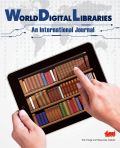Authors: Kar, Debal C
Article Type:
Research Article
Abstract:
Digital Library of India (DLI) is an initiative taken by the Government of India to digitally preserve and disseminate all the significant literary, artistic, and scientific work of human available in India and thus, it has been made freely available, from every corner of the world, for education, study, appreciation, and for the future generations. The project started with the primary long-term objective of capturing all copyright free books and manuscripts, available in India, in digital format. The planning started with an aim to digitize one million books (less than one per cent of all books in all languages ever
…published) by 2005 in the first phase. Presently, it has succeeded in disseminating 537,350 books with 187656339 pages in 46 languages (Indian and Foreign) available in India. The books and manuscripts are available on the website with free access at <www.dli.gov.in > and <www.dli.ernet.in >. The Government of India has also taken initiatives to digitize cultural heritage, such as facts, monuments, heritage building, temples, and a thousand-year-old manuscripts and walk-through. The article also discuss about the initiation, planning, and successful execution of the project. The expenditure incurred as of today, the sources of fund and coverage in respect of subjects, languages, type of collections (e.g. books, manuscripts, hand written manuscripts in leafs, journals, newspapers, etc.), libraries, cities, centres, and many more. It will be also described how the different libraries and digitization centres share their resources and network amongst each other for better usage of the documents available since 1985 or earlier. The article will also describe the philosophy behind the content selection, duplication of work, and copyright issues policy of the projects. Furthermore, the process workflow for the digitization of books shall be summarized in terms of three major process elements—pre scanning process, scanning process, and post scanning process and tools used. The criteria behind deciding which manuscripts are to be included in the collection for digitization is also described. The article will also provide the language-wise as well as centre-wise status of the digital collection. The digitization process used, steps taken pre-digitization and the process used post-digitization have also been described in detail. Besides, the article also discusses the necessary precautions taken for preserving of the digitized data and steps for dissemination across the world. Other projects and actions initiated, thus far, to educate and empower human resources and outreach activities to popularize DLI and increase the usage have also been elaborated upon. Statistics to show the usage and number pages downloaded in a particular month have also been provided. While concluding, the article describes the benefits derived from project DLI and usage of the initiatives of the preservation and dissemination of national heritage and suggested future plans to popularize DLI on rare books and manuscripts.
Show more
Keywords: Digital Library of India, Rare Books, Digitization of Books
DOI: 10.18329/09757597/2016/9104
Citation: World Digital Libraries - An international journal,
vol. 9, no. 1, pp. 45-60, 2016
Price: EUR 27.50






